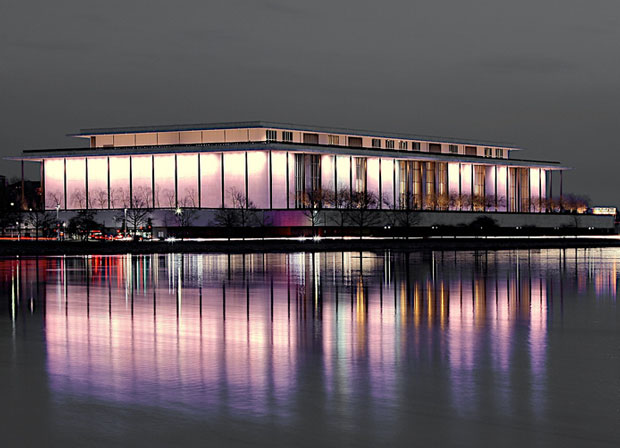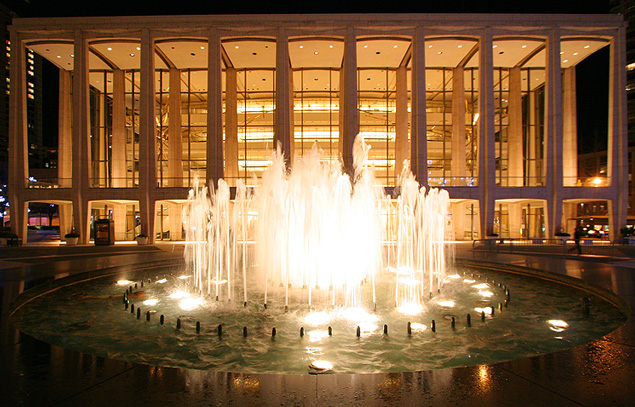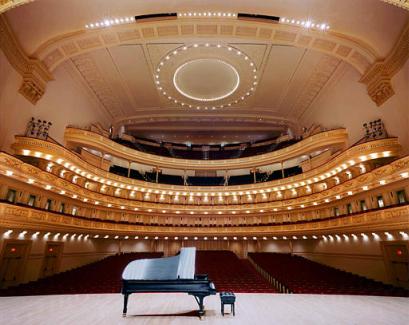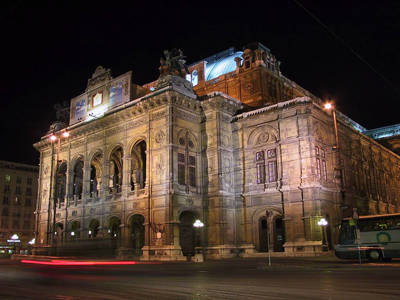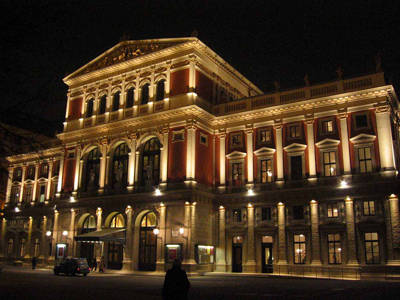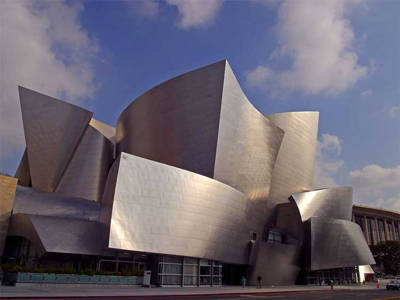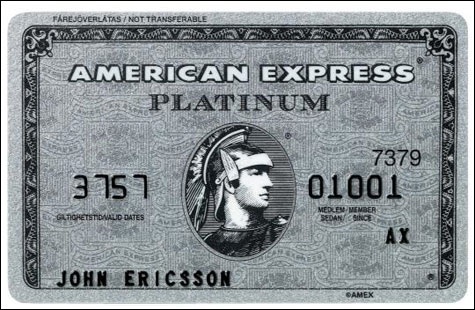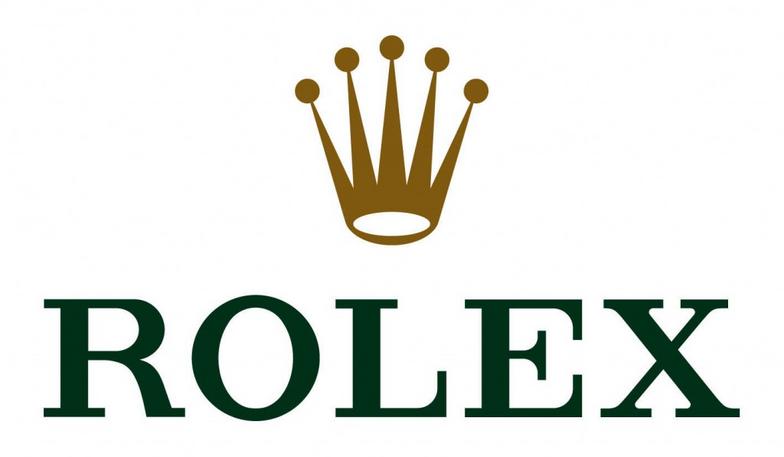Classic America
"Pops Concert Channel"
"Mostly Sinatra Channel"
The World's Greatest Music!
News and Reviews for Classic America "Events"
Kennedy Center Washington DC . Click here to go to the Kennedy Center web site.
Royal Albert Hall London. Click here to go to the Royal Albert Hall web site.
Lincoln Center New York City. Click here to go to the Lincoln Center Web Site.
Carnegie Hall ( /ˈkɑrnɨɡi/, also frequently /kɑrˈneɪɡi/ or /kɑrˈnɛɡi/] is a concert venue in Midtown Manhattan in New York City, United States, located at 881 Seventh Avenue, occupying the east stretch of Seventh Avenue between West 56th Street and West 57th Street, two blocks south of Central Park.
Designed by architect William Burnet Tuthill and built by philanthropist Andrew Carnegie in 1891, it is one of the most prestigious venues in the world for both classical music and popular music. Carnegie Hall has its own artistic programming, development, and marketing departments, and presents about 250 performances each season. It is also rented out to performing groups. The hall has not had a resident company since 1962, when the New York Philharmonic moved to Lincoln Center's Philharmonic Hall (renamed Avery Fisher Hall in 1973).
Other concert halls that bear Carnegie's name include 420-seat Carnegie Hall in Lewisburg, West Virginia; 1928-seat Carnegie Music Hall in Pittsburgh, Pennsylvania, on the main site of the Carnegie Museums of Pittsburgh; 1022-seat Carnegie Music Hall annexed to Pittsburgh suburb Homestead's Carnegie library; and Carnegie Hall, a 540-seat venue, in Andrew Carnegie's native Dunfermline.
The Royal Albert Hall is a concert hall situated on the northern edge of the South Kensington area, in the City of Westminster, London, England, best known for holding the annual summer Proms concerts since 1941.
It is one of the UK's most treasured and distinctive buildings, recognisable all over the world. Since its opening by Queen Victoria in 1871, the world's leading artists from every kind of performance genre have appeared on its stage. Each year it hosts more than 350 performances including classical concerts, rock and pop, ballet and opera, tennis, award ceremonies, school and community events, charity performances and banquets.
The hall was originally supposed to have been called The Central Hall of Arts and Sciences, but the name was changed by Queen Victoria to Royal Albert Hall of Arts and Sciences when laying the foundation stone as a dedication to her deceased husband and consort Prince Albert. It forms the practical part of a national memorial to the Prince Consort – the decorative part is the Albert Memorial directly to the north in Kensington Gardens, now separated from the Hall by the road Kensington Gore.
Lincoln Center for the Performing Arts is a 16.3-acre (6.6 ha) complex of buildings in the Lincoln Square neighborhood of New York City's Upper West Side. Reynold Levy has been its president since 2002.A consortium of civic leaders and others led by, and under the initiative of John D. Rockefeller III, built Lincoln Center as part of the "Lincoln Square Renewal Project" during Robert Moses's program of urban renewal in the 1950s and 1960s.[1] Seventeen blocks of ethnic tenement neighborhoods were demolished through eminent domain, forcing out 7,000 families.[2] Respected architects were contacted to design the major buildings on the site, and over the next thirty years the previously blighted area around Lincoln Center became a new cultural hub.[2] Rockefeller was Lincoln Center's inaugural president from 1956 and became its chairman in 1961. He is credited with raising more than half of the $184.5 million in private funds needed to build the complex, including drawing on his own funds; the Rockefeller Brothers Fund also contributed to the project.
The John F. Kennedy Center for the Performing Arts (on the building itself called the John F. Kennedy Memorial Center for the Performing Arts, and commonly referred to as the Kennedy Center) is a performing arts center located on the Potomac River, adjacent to the Watergate complex in Washington, D.C. The Center, which opened on September 8, 1971, produces and presents theater, dance, ballet, orchestral, chamber, jazz, popular, and folk music, in addition to multi-media performances for all ages.
It is the nation’s busiest performing arts facility and annually hosts approximately 2,000 performances for audiences totaling nearly two million.
It represents a public-private partnership, since it is both the nation's living memorial to President John F. Kennedy and the "national center for the performing arts", which includes educational and outreach initiatives, almost entirely paid for through ticket sales and gifts from individuals, corporations, and private foundations.
Designed by architect Edward Durrell Stone, it was built by Philadelphia contractor John McShain and is administered by a bureau of the Smithsonian Institution. It receives federal funding each year to pay for the maintenance and operation of the building.
The Vienna State Opera. Click here to go to the Vienna State Opera website
As well as being one of the oldest in the world, The Vienna State Opera is the oldest and longest running opera in the Germanic countries. The Vienna State Opera performs over 50 operas and 15 ballets in their 300 day season. The construction of the original building began in 1863 and ended in 1869, however, during World War II, the building was ravaged by fire and bombs. The stage and the theater's 150,000+ costumes and props were lost. The theater reopened on November 5, 1955.
The Mushikverein,Vienna Austria, Click here to go to the Mushikverein website
Along with the Boston Symphony Hall, Vienna's Musikverein is considered one of the best hall's in the world. Said to be the "Golden Sound in the Golden Hall," the Musikverein's beautifully ornate auditorium combined with its exquisite sound truly make this a world class concert hall.long with the Boston Symphony Hall, Vienna's Musikverein is considered one of the best hall's in the world. Said to be the "Golden Sound in the Golden Hall," the Musikverein's beautifully ornate auditorium combined with its exquisite sound truly make this a world class concert hall.
Wiener Musikverein, (German pronunciation: [ˌviːnɐ̯ muˌziːkfɛʁˈʔaɪ̯n]; English: "Viennese Music Association"), commonly shortened to The Musikverein, has a twofold meaning: it is the name of a famous Vienna concert hall, as well as the short name for the music society, Gesellschaft der Musikfreunde [Society of Music Friends], that owns the building.
This building is located on Dumbastraße behind the Imperial Hotel, .
The concert hall was built by the Gesellschaft der Musikfreunde, on a piece of land given by Emperor Franz Joseph, and it was opened on January 6, 1870. A historic organ was installed in it by the Austrian firm Rieger, in 1907. The Musikverein is famous for its acoustics and is considered to be one of the five finest concert/opera venues in the world. None of these halls was built in the modern era with the application of acoustics science, and, with the partial exception of the horseshoe-shaped Colon, all share a long, tall, and narrow shape. It is the home to the Vienna Philharmonic.. Every year, the Vienna New Year's Concert is held here.
The Boston Symphony Hall, Click here to go to the Boston Symphony Hall website.
The Boston Symphony Hall is considered by many to be one of the finest concert halls in the world, and is home to the Boston Symphony Orchestra and the Boston Pops. The Boston Symphony Hall was the first concert hall ever built on scientifically derived acoustical engineering. The hall's 1.9 second reverberation time is considered ideal for orchestral performances. Everything was designed for ideal sound, no matter where you sat in the auditorium. The Boston Symphony Hall was designed after Vienna's Musikverein. Inside, the decor is minimal (it's all about the sound right?), and the leather seats are still original
The Symphony Hall organ, a 4,800-pipe Aeolian-Skinner (Opus 1134) designed by G. Donald Harrison, installed in 1949, and autographed by Albert Schweitzer, is considered one of the finest concert hall organs in the world.[citation needed] It replaced the hall's first organ, built in 1900 by George S. Hutchings of Boston, which was electrically keyed, with 62 ranks of nearly 4,000 pipes set in a chamber 12 feet deep and 40 feet high. The Hutchings organ had fallen out of fashion by the 1940s when lighter, clearer tones became preferred. E. Power Biggs, often a featured organist for the orchestra, lobbied hard for a thinner bass sound and accentuated treble.
The 1949 Aeolian-Skinner reused and modified more than 60% of the existing Hutchings pipes and added 600 new pipes in a Positiv division. The original diapason pipes, 32 feet in length, were reportedly sawed into manageable pieces for disposal in 1948.
In 2003 the organ was thoroughly overhauled by Foley-Baker Inc., reusing its chassis and many pipes, but enclosing the Bombarde and adding to it the long-desired Principal (diapason) pipes, adding a new Solo division, and reworking its chamber for better sound projection.
The Walt Disney Concert Hall, Los Angeles, CA, Click here to go to the Walt Disney Concert Hall website.
The youngest on our list, the Walt Disney Concert Hall was designed by Frank Gehry to be one of the most acoustically accurate concert halls in the world. From the design start in 1987, it took 16 years for the project to be completed. A six-level subterranean parking garage was first built, and in 1999 the construction of the concert hall began. The Walt Disney Concert Hall in downtown L.A. is now home to the Los Angeles Philharmonic.
The Bolshoi Theatre, Click here to go to the Bolshoi website
(Russian: Большой театр, Bol'shoy Teatr, meaning Large, Great or Grand Theatre, also spelled Bolshoy) is a historic theatre in Moscow, Russia, designed by architect Joseph Bové, which holds performances of ballet and opera. The Bolshoi Ballet and Bolshoi Opera are amongst the oldest and most renowned ballet and opera companies in the world. The theatre is the parent company of The Bolshoi Ballet Academy, a world-leading school of ballet.
The main building of the theatre, rebuilt and renovated several times during its history, is a landmark of Moscow and Russia (its iconic neoclassical facade is depicted on the Russian 100-ruble banknote). On 28 October 2011, the Bolshoi was re-opened after an extensive six year renovation costing about 21 billion rubles (about $680 million) .The renovation included restoring acoustics to the original quality (which had been lost during the Soviet Era), as well as restoring the original Imperial decor of the Bolshoi.

